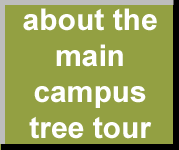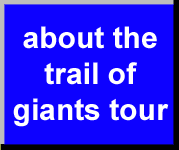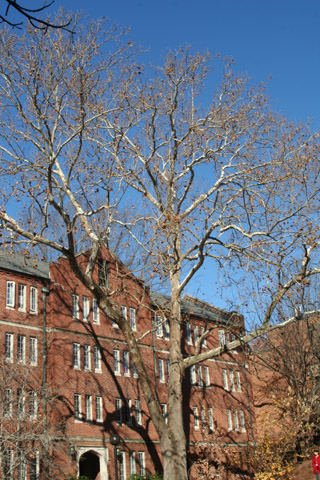 |  |  |  |
 |  |  |  |
An individual instance of Platanus occidentalis (American sycamore)

Permanent unique identifier for this particular organism:
http://bioimages.vanderbilt.edu/vanderbilt/7-205
Notes:
This giant tree near the side entrance of Cole Hall facing the Power House is the largest sycamore in the arboretum, with a diameter of 103 cm (41 in.), height of 27 m (89 ft.), and crown spread of 29 m (95 ft.).
Sycamore is a tree that is easy to recognize. Although its leaves are similar to maple leaves, they are arranged alternately on the twig, rather than opposite as are maples. The bark of sycamore is one of the most distinctive features of the species. As the trees age, bark begins to peel off in irregularly shaped chunks. This gives the tree a "camouflage" look with the different-aged exposed layers having different shades of green and brown. On young trees and branches, the predominance of whitish bark makes the species stand out, especially in the winter time when leaves are absent.
The fruit of sycamore is also unique. The fruit is a hanging ball. As it matures and dries, hairs attached to the seeds behave as a parachute when the seeds come loose from the ball.
Sycamore is a very common native tree that is usually found along streams and rivers. On Vanderbilt campus, it is easy to confuse the few sycamore trees with the numerous, non-native London plane trees that have been planted and which look quite similar to sycamore. The London plane trees tend to have greener upper bark, while the upper bark of sycamore tends to be white.
This tree is described on p. 60 of The Trees of Vanderbilt.
Sycamore is a tree that is easy to recognize. Although its leaves are similar to maple leaves, they are arranged alternately on the twig, rather than opposite as are maples. The bark of sycamore is one of the most distinctive features of the species. As the trees age, bark begins to peel off in irregularly shaped chunks. This gives the tree a "camouflage" look with the different-aged exposed layers having different shades of green and brown. On young trees and branches, the predominance of whitish bark makes the species stand out, especially in the winter time when leaves are absent.
The fruit of sycamore is also unique. The fruit is a hanging ball. As it matures and dries, hairs attached to the seeds behave as a parachute when the seeds come loose from the ball.
Sycamore is a very common native tree that is usually found along streams and rivers. On Vanderbilt campus, it is easy to confuse the few sycamore trees with the numerous, non-native London plane trees that have been planted and which look quite similar to sycamore. The London plane trees tend to have greener upper bark, while the upper bark of sycamore tends to be white.
This tree is described on p. 60 of The Trees of Vanderbilt.
 |  |
Load database and switch to thumbnail view
Use this stable URL to link to this page:
http://bioimages.vanderbilt.edu/vanderbilt/7-205.htm
This organism is a living specimen that is part of the Vanderbilt University Arboretum with the local identifier 3-52.
This particular organism is believed to have managedmeans of establishment.
This organismal entity has the scope: multicellular organism.
Identifications:
Platanus occidentalis
L.
sec. fna.org 1993
common name: American sycamore
family: Platanaceae
Identified 2003-09-29 by Steven J. Baskauf
Location:
Vanderbilt University, Nashville, Davidson County, Tennessee, US
Click on these geocoordinates to load a map showing the location: 36.14628°, -86.80411°
Coordinate uncertainty about: 10 m.
Location of individual determined from GIS database.
Occurrences were recorded for this particular organism on the following dates:
2003-09-29
2013-12-11
2014-09-03
The following images document this particular organism.
Click on a thumbnail to view the image and its metadata.Load database and enable navigation by taxon and organism.
| Image | View |
 | whole tree (or vine) - general |
 | whole tree (or vine) - winter |
 | leaf - whole upper surface |